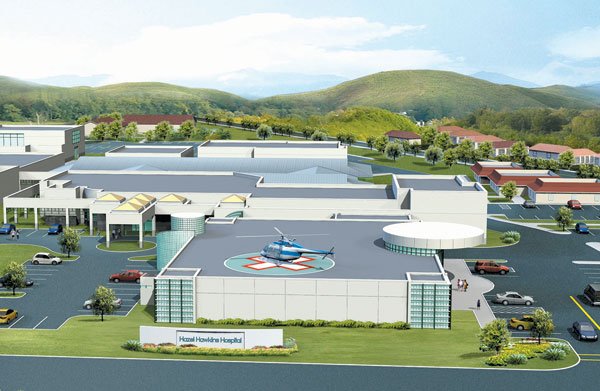As the South Valley region is braced for continued growth, area
health systems are faced with a delicate balance of pushing forward
efficient expansions vital to their survival while meeting unique
needs of local consumers in tough economic times.
As the South Valley region is braced for continued growth, area health systems are faced with a delicate balance of pushing forward efficient expansions vital to their survival while meeting unique needs of local consumers in tough economic times.
It’s a lot to swallow, but Gilroy’s Saint Louise Regional Hospital and Hollister’s Hazel Hawkins Memorial Hospital are striving to do just that by expanding facilities and streamlining technology to serve more people and do it as productively as possible.
Each health care system, though tied together by comparable economics and demographics, has had its own obstacles to overcome and apparent challenges to face in the coming years.
Saint Louise – ‘fastest turnaround times’
Caring for Santa Clara County’s fastest growing population amid tough economic times means Gilroy’s Saint Louise Regional Hospital has to become more efficient to honor its Catholic mission. As a member of the Daughters of Charity Health System, the 19-year-old hospital has already demonstrated its evolutionary knack by opening a state-of-the-art wound care center earlier this month. Now the 93-bed hospital, 50 of which are filled regularly, is about to start using time-saving testing technology to stave off staph infections, and for the past three years it has streamlined its emergency room triage with telecommunications.
While a further recession and potential state budget cuts could hamper the ER’s expansion, “we’re always making a priority list,” said Joanne Allen, the hospital’s president and CEO since Jan. 2. “Just like a person might not buy that new car this year and hold off until next year, we might not buy a new piece of technology, but we’ll still expand our services.”
This is evident in the emergency room, where electronics imbue the under-sized center to allow the hospital’s 481 associates access to medical records and the ability to order and view lab work, medication and X-rays from nearly anywhere. Even at 3 a.m., they can send skeletal images from a patient’s bedside to a “nighthawk tele-radiologist” in Australia who reviews the images and sends them back for the local doctor’s response. This, in turn, has facilitated the hospital’s “rapid medical evaluation,” said Dr. Pamela Stuart, the medical director of emergency services who has worked at the hospital for the past 17 years along with her husband, Dr. Kevin Stuart, a gastroenterologist.
“What hasn’t changed since I came is the space, the rooms, the physical lay-out. We’ve gone from about 13,000 (emergency room patients per year) in 1991 to about 26,000 now,” Stuart said. “But what has changed is the way we do everything – the patient ordering, the labs.”
While the ER could expand by four times and still not have enough room because Gilroy and Morgan Hill are growing so quickly, Stuart cautioned that RME has improved patient care “even if we don’t have a bed for them.” And with about 26,000 ER patients a year, “there’s no place in the county seeing that kind of volume per bed,” said Stuart, adding a complimentary comment on the hospital’s ER efforts.
“One of the things I’m proudest about is that we have double the volume compared to the county, yet we have the fastest turnaround times,” Stuart said.
Allen pointed to additional technology such as software programs that create surgical road maps for individual patients. This has reduced unnecessary incisions and shortened patients stays by days, she said. Then there’s the new MRSA testing equipment – the first in the county – thanks to donations from the Partners for Healthcare Excellence Campaign headed by garlic business magnates and community philanthropists, Don and Karen Christopher.
The hospital will begin using the real-time equipment May 1 to test for Methicillin-resistant Staphylococcus aureus, a staph infection. The results will come back in about two hours – instead of two days – and further reduce stays due to undetected bacteria. VRE and TB tests will follow the same path in the near future, too.
Technology aside, the hospital’s next steps will likely be moving staff around to make more room for patients and, maybe someday, expanding the ER by at least 20 beds, said Allen, who has spoken with State Sen. Elaine Alquist and State Assemblywoman Anna Caballero about Saint Louise’s ER crunch.
Along with the hospital’s other chief officers, medical directors and consultants, Allen reconciles economic factors, patient input and Saint Louise’s Vincentian mission statement to come up with future strategies, she said. This kind of thinking beefed up outpatient services such as radiation oncology and yielded the new Center for Wound Care and Hyperbaric Medicine.
The hospital welcomed its first patient Jan. 28 to the new wound center, which uses a form of medicine that speeds up the healing process by using gaseous pressure to administer high concentrations of oxygen to patients. They slide into one of two clear cylindrical chambers at the hospital – named Novellus and Calypso – and soak in 100 percent oxygen for about two hours a day, five days a week, for anywhere from four to eight weeks depending on their particular wounds.
Technology and luxury merge with the two 14-inch flat screens with cable that sit atop the chambers. The hospital hopes to treat about 200 outpatients at the center this year as word gets out. The center cost about $750,000 and took two years to materialize.
Hazel Hawkins – a ‘little gem’
Hazel Hawkins, meanwhile, has more immediate plans for expanding its emergency room and other facilities. It’s in the midst of adding 50,000 square feet of construction, including a new ER that will be about three times the size of the current one.
It’s happening because hospital leaders and supporters convinced nearly 80 percent of district voters in 2005 to approve a $31.5 million bond.
The ER’s expansion should significantly help alleviate inherent problems at the hospital with long waits – on weekends, there often have been lines out the hallway of people waiting for one of three beds – and doctors working in cramped spaces.
The new ER will have 10 private rooms and other specialty rooms and beds, allowing staff to accommodate more people.
With the expansion – such as better equipment to detect cancer and heart problems and a new women’s center – doctors also say the update should keep patients closer to home instead of traveling to Gilroy or San Jose for specialized care.
“Hazel Hawkins is not the hospital it was 20 years ago,” said Dr. Peter Coelho, a family-medicine private practitioner. “It’s going to be a nice new facility with a whole new crew of doctors.”
The hard part, then, is in the past, right?
That’s yet to be determined in a San Benito County medical community struggling to keep doctors based and working in the Hollister area.
There are 42 active physicians, but about 25 of them are based here permanently, said Joan Rogers, medical staff director for Hazel Hawkins.
Like any doctors, their constant challenge is keeping costs under control. And in the past year, that prospect was threatened severely by proposed reductions in Blue Cross reimbursements. Compounding the problem was federal legislation proposing to increase Medicare reimbursement amounts in surrounding counties while keeping rates relatively flat here.
Many thought either possibly could taint the county’s image and lead to fewer doctors coming here and more leaving the area. Coelho noted how the community already had many obstetric (O.B.) doctors leaving the county because the nonprofit San Benito Health Foundation – to which the hospital community is not directly affiliated – sends many patients out of county.
With a united front, community support and help from legislators and insurance representatives, those reimbursement concerns – bringing likely profit losses and increased consumer costs – were averted for now.
“A small community banded together and really influenced a large corporate monster,” Coelho said. “That was very impressive. That was a terrific job from a small community.”
They’re not free from worries yet, though. The current Medicare reimbursement rates are up for potential re-tooling this summer, noted Dr. Ralph Armstrong, president of the San Benito County Medical Society.
He has his thoughts on private insurance companies, too.
“Insurance companies don’t care about rising practice costs,” Armstrong said. “Eventually, there’s going to be a cutoff point where people … decide to go to another profession.”
Despite challenges here in San Benito County, Coelho thinks many community-oriented businesses, including the hospital, offer a lot to local residents.
“It’s a nice little gem for the county,” he said.
What Saint Louise and Hazel Hawkins offer
Saint Louise
Critical care services and maternal child service
Pediatric surgery
Orthopedic surgical interventions
Oncology
Patients requiring telemetry monitoring
Integumentary disease
Neurologic disease
Gastrointestinal intervention
Genitourinary intervention
Blood product transfusion
IV chemotherapy/medication infusion
Therapeutic phlebotomy
Mediport/CVAD flush
Subcutaneous/IM injection
Line insertion
Wound care/dressing changes
Hazel Hawkins
50,000 square feet of new facilities
Five new buildings, including a new emergency room almost three times the current one’s size
New technology and furnishings to treat 30,000 patients a year
New obstetrics and rehabilitation unit
Upgraded lab and diagnostic imaging services
Many pieces of advanced medical equipment to detect cancer and treat heart problems
How to volunteer
Saint Louise
Volunteers work a minimum of two shifts a month for three and a half hours per shift. After your volunteer application is complete, an interview is scheduled. A volunteer orientation is provided.
If you are interested in becoming a of the Saint Louise Regional Hospital family, contact (408) 848-4919.
Hazel Hawkins
Reception: Two four-hour shifts, Monday through Friday
Escort: Three four-hour shifts, Monday through Friday
Surgery – Central Sterile: Four-hour shift. Monday, Wednesday, and Friday. Requires wearing surgical scrubs
Gift Shop: Three four-hour shifts Monday through Friday
Thrift Shop: Shifts usually 4-6 hours weekly
Special Projects
Resident Care: Usually four-hour shifts, but flexible
Sewing Committee
For information about volunteering, contact Babette Martin at (831) 637-5711 ext. 2287.













